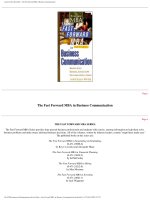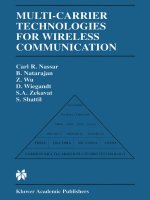Cellular communication
Bạn đang xem bản rút gọn của tài liệu. Xem và tải ngay bản đầy đủ của tài liệu tại đây (735.41 KB, 48 trang )
Cellular Communication
Evolution to cellular networks –
communication anytime, anywhere
radio communication was invented by Nikola Tesla and Guglielmo Marconi:
in 1893, Nikola Tesla made the first public demonstration of wireless
(radio) telegraphy; Guglielmo Marconi conducted long ditance (over see)
telegraphy 1897
in 1940 the first walkie-talkie was used by the US military
in 1947, John Bardeen and Walter Brattain from AT&T’s Bell Labs invented
the transistor (semiconductor device used to amplify and switch electronic
signals)
AT&T introduced commercial radio comm.: car phone – two way radio link
to the local phone network
in 1979 the first commercial cellular phone service was launched by the
Nordic Mobile Telephone (in Finland, Sweden, Norway, Denmark).
Cellular systems generations
1G (first generation) – voice-oriented systems based on
analog technology; ex.: Advanced Mobile Phone Systems
(AMPS) and cordless systems
2G (second generation) - voice-oriented systems based
on digital technology; more efficient and used less
spectrum than 1G; ex.: Global System for Mobile (GSM)
and US Time Division Multiple Access (US-TDMA)
3G (third generation) – high-speed voice-oriented
systems integrated with data services; ex.: General
Packet Radio Service (GPRS), Code Division Multiple
Access (CDMA)
4G (fourth generation) – still experimental, not deployed
yet; based on Internet protocol networks and will provide
voice, data and multimedia service to subscribers
Frequency reuse
is a method used by service providers to improve the
efficiency of a cellular network and to serve millions of
subscribers using a limited radio spectrum
is based on the fact that after a distance a radio wave
gets attenuated and the signal falls bellow a point
where it can no longer be used or cause any
interference
a transmitter transmitting in a specific frequency range
will have only a limited coverage area
beyond this coverage area, that frequency can be
reused by another transmitter
Network Cells
the entire network coverage area is divided into cells
based on the principle of frequency reuse
a cell = basic geographical unit of a cellular network; is
the area around an antenna where a specific frequency
range is used; is represented graphically as a hexagonal
shape, but in reality it is irregular in shape
when a subscriber moves to another cell, the antenna
of the new cell takes over the signal transmission
a cluster is a group of adiacent cells, usually 7 cells; no
frequency reuse is done within a cluster
the frequency spectrum is divided into subbands and
each subband is used within one cell of the cluster
in heavy traffic zones cells are smaller, while in isolated
zones cells are larger
Network cells (2)
Types of cells
macrocell – their coverage is large (aprox. 6 miles in
diameter); used in remote areas, high-power
transmitters and receivers are used
microcell – their coverage is small (half a mile in
diameter) and are used in urban zones; low-powered
transmitters and receivers are used to avoid
interference with cells in another clusters
picocell – covers areas such as building or a tunnel
Other cellular concepts
handover = moving a call from one zone (from the
transmitter-receiver from one zone) to another zone
due to subscriber’s mobility
roaming = allowing the subscriber to send/receive
calls outside the service provider’s coverage area
Multiple access schemes
Frequency Division Multiple
Access
- when the subscriber enters
another cell a unique frequency is
assigned to him; used in analog
systems
Time Division Multiple Access
Code Division Multiple Access
- each subscriber is assigned a time
slot to send/receive a data burst; is
used in digital systems
- each subscriber is assigned a code
which is used to multiply the signal
sent or received by the subscriber
The control channel
this channel is used by a cellular phone to indicate its
presence before a frequency/time slot/code is
allocated to him
Cellular services
voice communication
Short Messaging Service (SMS)
Multimedia Messaging Service (MMS)
Global Positioning System (GPS)
Wireless Application Protocol (WAP) – to access the
Internet
Cellular network components
Cellular network components (2)
BTS (Base Transceiver Station) – main component of a
cell and it connects the subscribers to the cellular
network; for transmission/reception of information it
uses several antennas spread across the cell
BSC (Basic Station Controller) – it is an interface
between BTSs and it is linked to BTSs by cable or
microwave links; it routes calls between BTSs; it is also
connected to the MSC
MSC (Mobile Switching Center) – the coordinator of a
cellular network, it is connected to several BSCs, it
routes calls between BSCs; links the cellular network
with other networks like PSTN through fiber optics,
microwave or copper cable
Components of a cellular phone
(MSU – Mobile Subscriber Unit)
radio transceiver – low power radio transmitter and
receiver
antenna, usually located inside the phone
control circuitry – formats the data sent to and from
the BTS; controls signal transmission and reception
man-machine interface – consists from a keypad and a
display; is managed by the control circuitry
Subscriber Identity Module (SIM) – integrated circuit
card that stores the identity information of subscriber
battery, usually Li-ion, the power unit of the phone
Setting up a call process
when powered on, the phone does not have a frequency/
time slot/ode assigned to it yet; so it scans for the control
channel of the BTS and picks the strongest signal
then it sends a message (including its identification
number) to the BTS to indicate its presence
the BTS sends an acknowledgement message back to the
cell phone
the phone then registers with the BTS and informs the
BTS of its exact location
after the phone is registered to the BTS, the BTS assigns
a channel to the phone and the phone is ready to receive
or make calls
Making a call process
the subscriber dials the receiver’s number and sends it to
the BTS
the BTS sends to its BSC the ID, location and number of
the caller and also the number of the receiver
the BSC forwards this information to its MSC
the MSC routes the call to the receiver’s MSC which is
then sent to the receiver’s BSC and then to its BTS
the communication with the receiver’s cell phone is
established
Receiving a call process
when the receiver’ phone is in an idle state it listens for
the control channel of its BTS
if there is an incoming call the BSC and BTS sends a
message to the cells in the area where the receiver’s
phone is located
the phone monitors its message and compares the
number from the message with its own
if the numbers matches the cell phone sends an
acknowledgement to the BTS
after authentication, the communication is established
between the caller and the receiver
Global System for Mobile
Communication (GSM)
GSM characteristics
previous standard in cellular communication were
restrictive
GSM – global digital standard for cellular phones that
offered roaming facility
first named Groupe Special Mobile and used in Europe;
then usage extended to other continents
GSM operate in frequency bands: 900MHz, 1800 MHz,
1900 MHz
GSM provides voice and data services
Subscriber Identity Module (SIM)
card
SIM – a memory card (integrated circuit) holding
identity information, phone book etc.
GSM system support SIM cards
other systems, like CDMA do not support SIM cards, but
have something similar called Re-Usable Identification
Module (RUIM)
International Mobile Equipment
Identity (IMEI) key
IMEI – a unique 15 digit number identifying each
phone, is incorporated in the cellular phone by the
manufacturer
IMEI ex.: 994456245689001
when a phone tries to access a network, the service
provider verifies its IMEI with a database of stolen
phone numbers; if it is found in the database, the
service provider denies the connection
the IMEI is located on a white sticker/label under the
battery, but it can also be displayed by typing *#06#
on the phone
International Mobile Subscriber
Identity (IMSI) key
IMSI – a 15-digit unique number provided by the
service provider and incorporated in the SIM card
which identifies the subscriber
IMSI enables a service provider to link a phone
number with a subscriber
first 3 digits of the IMSI are the country code
Temporary Mobile Subscriber Identity
(TMSI) key
TMSI – is a temporary number, shorter than the IMSI,
assigned by the service provider to the phone on a
temporary basis
TMSI key identifies the phone and its owner in the cell
it is located; when the phone moves to a different cell
it gets a new TMSI key
as TMSI keys are shorter than IMSI keys they are
more efficient to send
TMSI key are used for securing GSM networks
GSM architecture
Base Station Subsystem (BSS)









